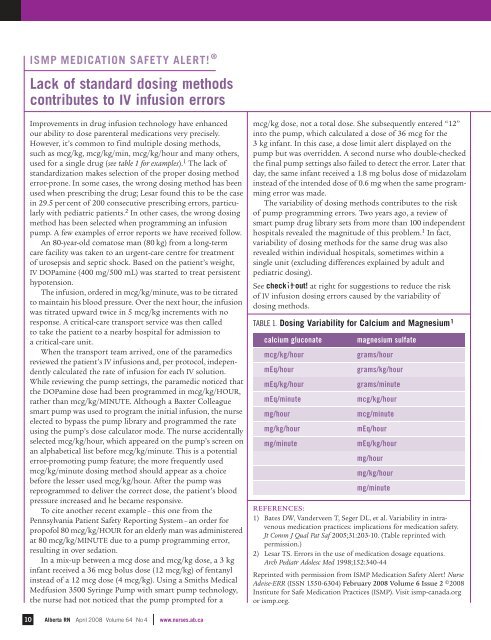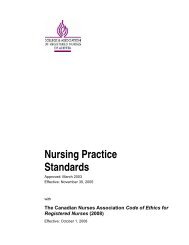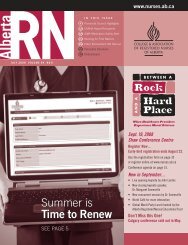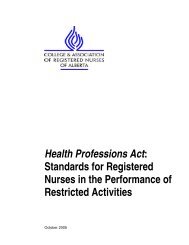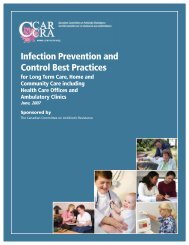I am a nurse. - College & Association of Registered Nurses of Alberta
I am a nurse. - College & Association of Registered Nurses of Alberta
I am a nurse. - College & Association of Registered Nurses of Alberta
Create successful ePaper yourself
Turn your PDF publications into a flip-book with our unique Google optimized e-Paper software.
10<br />
ISMP MEDICATION SAFETY ALERT! ®<br />
Lack <strong>of</strong> standard dosing methods<br />
contributes to IV infusion errors<br />
Improvements in drug infusion technology have enhanced<br />
our ability to dose parenteral medications very precisely.<br />
However, it’s common to find multiple dosing methods,<br />
such as mcg/kg, mcg/kg/min, mcg/kg/hour and many others,<br />
used for a single drug (see table 1 for ex<strong>am</strong>ples). 1 The lack <strong>of</strong><br />
standardization makes selection <strong>of</strong> the proper dosing method<br />
error-prone. In some cases, the wrong dosing method has been<br />
used when prescribing the drug; Lesar found this to be the case<br />
in 29.5 per cent <strong>of</strong> 200 consecutive prescribing errors, particularly<br />
with pediatric patients. 2 In other cases, the wrong dosing<br />
method has been selected when progr<strong>am</strong>ming an infusion<br />
pump. A few ex<strong>am</strong>ples <strong>of</strong> error reports we have received follow.<br />
An 80-year-old comatose man (80 kg) from a long-term<br />
care facility was taken to an urgent-care centre for treatment<br />
<strong>of</strong> urosepsis and septic shock. Based on the patient’s weight,<br />
IV DOP<strong>am</strong>ine (400 mg/500 mL) was started to treat persistent<br />
hypotension.<br />
The infusion, ordered in mcg/kg/minute, was to be titrated<br />
to maintain his blood pressure. Over the next hour, the infusion<br />
was titrated upward twice in 5 mcg/kg increments with no<br />
response. A critical-care transport service was then called<br />
to take the patient to a nearby hospital for admission to<br />
a critical-care unit.<br />
When the transport te<strong>am</strong> arrived, one <strong>of</strong> the par<strong>am</strong>edics<br />
reviewed the patient’s IV infusions and, per protocol, independently<br />
calculated the rate <strong>of</strong> infusion for each IV solution.<br />
While reviewing the pump settings, the par<strong>am</strong>edic noticed that<br />
the DOP<strong>am</strong>ine dose had been progr<strong>am</strong>med in mcg/kg/HOUR,<br />
rather than mcg/kg/MINUTE. Although a Baxter Colleague<br />
smart pump was used to progr<strong>am</strong> the initial infusion, the <strong>nurse</strong><br />
elected to bypass the pump library and progr<strong>am</strong>med the rate<br />
using the pump’s dose calculator mode. The <strong>nurse</strong> accidentally<br />
selected mcg/kg/hour, which appeared on the pump’s screen on<br />
an alphabetical list before mcg/kg/minute. This is a potential<br />
error-promoting pump feature; the more frequently used<br />
mcg/kg/minute dosing method should appear as a choice<br />
before the lesser used mcg/kg/hour. After the pump was<br />
reprogr<strong>am</strong>med to deliver the correct dose, the patient’s blood<br />
pressure increased and he bec<strong>am</strong>e responsive.<br />
To cite another recent ex<strong>am</strong>ple – this one from the<br />
Pennsylvania Patient Safety Reporting System – an order for<br />
prop<strong>of</strong>ol 80 mcg/kg/HOUR for an elderly man was administered<br />
at 80 mcg/kg/MINUTE due to a pump progr<strong>am</strong>ming error,<br />
resulting in over sedation.<br />
In a mix-up between a mcg dose and mcg/kg dose, a 3 kg<br />
infant received a 36 mcg bolus dose (12 mcg/kg) <strong>of</strong> fentanyl<br />
instead <strong>of</strong> a 12 mcg dose (4 mcg/kg). Using a Smiths Medical<br />
Medfusion 3500 Syringe Pump with smart pump technology,<br />
the <strong>nurse</strong> had not noticed that the pump prompted for a<br />
<strong>Alberta</strong> RN April 2008 Volume 64 No 4 www.<strong>nurse</strong>s.ab.ca<br />
mcg/kg dose, not a total dose. She subsequently entered “12”<br />
into the pump, which calculated a dose <strong>of</strong> 36 mcg for the<br />
3 kg infant. In this case, a dose limit alert displayed on the<br />
pump but was overridden. A second <strong>nurse</strong> who double-checked<br />
the final pump settings also failed to detect the error. Later that<br />
day, the s<strong>am</strong>e infant received a 1.8 mg bolus dose <strong>of</strong> midazol<strong>am</strong><br />
instead <strong>of</strong> the intended dose <strong>of</strong> 0.6 mg when the s<strong>am</strong>e progr<strong>am</strong>ming<br />
error was made.<br />
The variability <strong>of</strong> dosing methods contributes to the risk<br />
<strong>of</strong> pump progr<strong>am</strong>ming errors. Two years ago, a review <strong>of</strong><br />
smart pump drug library sets from more than 100 independent<br />
hospitals revealed the magnitude <strong>of</strong> this problem. 1 In fact,<br />
variability <strong>of</strong> dosing methods for the s<strong>am</strong>e drug was also<br />
revealed within individual hospitals, sometimes within a<br />
single unit (excluding differences explained by adult and<br />
pediatric dosing).<br />
See checkitout! at right for suggestions to reduce the risk<br />
<strong>of</strong> IV infusion dosing errors caused by the variability <strong>of</strong><br />
dosing methods.<br />
TABLE 1. Dosing Variability for Calcium and Magnesium 1<br />
calcium gluconate magnesium sulfate<br />
mcg/kg/hour gr<strong>am</strong>s/hour<br />
mEq/hour gr<strong>am</strong>s/kg/hour<br />
mEq/kg/hour gr<strong>am</strong>s/minute<br />
mEq/minute mcg/kg/hour<br />
mg/hour mcg/minute<br />
mg/kg/hour mEq/hour<br />
mg/minute mEq/kg/hour<br />
mg/hour<br />
mg/kg/hour<br />
mg/minute<br />
REFERENCES:<br />
1) Bates DW, Vanderveen T, Seger DL, et al. Variability in intravenous<br />
medication practices: implications for medication safety.<br />
Jt Comm J Qual Pat Saf 2005;31:203-10. (Table reprinted with<br />
permission.)<br />
2) Lesar TS. Errors in the use <strong>of</strong> medication dosage equations.<br />
Arch Pediatr Adolesc Med 1998;152:340-44<br />
Reprinted with permission from ISMP Medication Safety Alert! Nurse<br />
Advise-ERR (ISSN 1550-6304) February 2008 Volume 6 Issue 2 ©2008<br />
Institute for Safe Medication Practices (ISMP). Visit ismp-canada.org<br />
or ismp.org.


